JEITA (Grotto) CAVERNS |
SCULPTED BY WATER AND TIME |
Few caverns in the world approach the astounding wealth or the extent of those of Jeita. In these caves and galleries, known to man since Paleolithic times, the action of water has created cathedral-like vaults beneath the wooded hills of Mount Lebanon. Geologically, the caves provide a tunnel or escape route for the underground river, which is the principle source of the Nahr el-Kalb (Dog River). Located some 20 kilometers along the highway North of Beirut, a large sign indicates the right turn from Zouk Mickael village, just beyond the tunnel. The caverns are on two levels. The lower galleries, discovered in 1836 and opened to the public in 1958, are visited by boat. The upper galleries, opened in January 1969, can be seen on foot. |

| To mark the inauguration of the upper galleries, arranged by the Lebanese artists and sculptor Ghassan Klink, the concert was organized in the cave featuring electronic music by the French composer Francois Bayle. Other cultural events have taken place in this unusual venue, including a concert by the German composer Karl-Heinrich Sttockhausen in November 1969. | 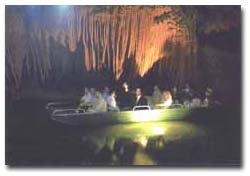 |
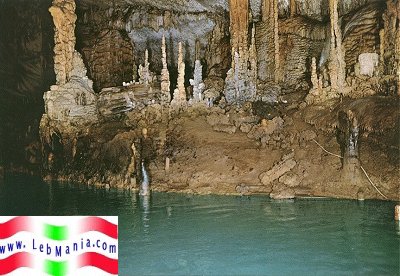
| Jeita remained a popular attraction until the recent Lebanese conflict forced it to close in the mid-1970’s. Upon the initiative of Minister of Tourism Nicolas Fattouch, the Ministry charged the German company “Mapas” to renovate and to re-equip its facilities by the most modern techniques and to operate the complex. On July 6, 1995, this natural wonder was again open to the public. |
 |
JEITA REDISCOVERED The modern discovery of the underground river of Jeita dates to 1836 and is attributed to Revered William Thomson, an American missionary who ventured some 50 meters into the cave. Reaching the underground river, he fired a shot from his gun and the resulting echoes convinced him that he had found a cavern of major importance. |
In 1873 W. J. Maxwell and H. G. Huxley, engineers with the Beirut Water Company, and their friend Reverend Daniel Bliss, President of the Syrian Protestant College (later the American University of Beirut) explored these caverns. In two expeditions carried out in 1873 and 1874 they penetrated 1,060 meters into the grotto - principal source of the Nahr el-Kalb that supplies Beirut with water. They were finally stopped by “Hell’s Rapids,” where the river flows in torrents over razor-sharp rocks. Like explorers everywhere, Dr. Bliss, Mr. Maxwell and the other engineers could not resist recording their names and the year on “Maxwell’s Column,” a great limestone pillar some 625 meters from the entrance. |
About 200 meters further on, in the so-called “Pantheon”, they wrote their names and their details of the expedition on a paper, sealed it in a bottle and placed it on top of a stalagmite. The action of the lime-impregnated water has since covered the bottle with a thin white film, permanently fixing it to the stone. Between 1892 and 1940 further expeditions were carried out, mostly by English, American or French explorers. These efforts brought them to a depth of 1,750 meters. |
Since the 1940’s, Lebanese explorers, notably the members of the Speleo-Club of Lebanon founded by the first Lebanese speleologist Lionel Ghorra, have pushed even deeper into the Jeita grotto. Their methodical exploration revealed the great underground system of the upper and lower galleries, which is now known to a depth approaching 9 kilometers. |
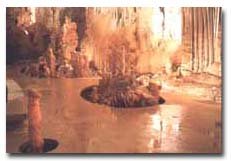 |
| The upper galleries, discovered in August 1958 by Lebanese speleologists, required a hazardous climb to 650 meters above the entrance of the underground river. Altogether, 2,130 meters of this gallery have been explored. |
INSIDE THE CAVERNS |
In summer you can visit both the upper and lower galleries while enjoying the refreshingly cool temperature inside the caves. The lower section is sometimes closed in winter when the water level is high, but the extensive upper galleries are open all year. Plan on about two hours for the tour, which includes a boat ride through the lower galleries, the visit to the upper galleries on foot and a film presentation. |
 |
THE LOWER GALLERIES This part of the cavern takes you to a beautiful underworld millions of years in the making. But the 600-meter boat trip on a subterranean lake is only a sampling of the system that has been explored for almost 6,910 meters. |
The first impression is the sound of rushing water and a sensation of clean cold. But the roar of the waterfall at the entrance gives way to profound silence as you glide deeper into the cave. An effective new lighting system illuminates the caverns allowing the visitors to glimpse the uppermost roofs - inaccessible even to expert rock climbers - and marvel at the columns and sculptures fashioned by those great architects - water and time. |

THE UPPER GALLERIES |
The approach to these dry galleries through 120-meter-long concrete tunnel does little to prepare you for the surprising world beyond. Formed several million years before the lower caverns, this section shows what the entire cave system was like before geological conditions displaced the subterranean river to its present level. For 650 meters you wind your way through different levels of the caverns, contemplating the flowing stones draperies and other formations. Perhaps the most dramatic sight is the yawning canyons and sink holes, some seen at a drop of over a hundred meters |
GETTING AROUND JEITA Leaving your car in the parking area, you purchase entry and parking tickets. From here the fun begins with a short ride up the mountain in one of four Austrian cable cars. If you prefer land transportation, a Disney-like “train” pulled by a small replica of a steam engine makes regular runs up and down the hill between the parking area and the upper galleries. |
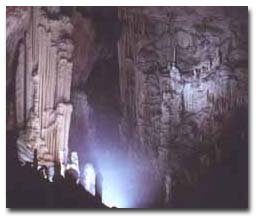 |
Near the entrance to the upper galleries is an air-conditioned theater, which has scheduled showings of a film about Jeita in several languages. Check which time the language you want is shown so you can coordinate the film with your visit to the cave. |
 |
The tickets you have bought double as access cards and are inserted at the entry gates of the upper and lower galleries and for the cable car. Also keep them handy for the train and the theater. When departing, your parking ticket is needed to exit the gate. The facility has several restaurants, snack bars and restrooms as well as souvenir shops selling Lebanese handicrafts. Open Tuesday through Thursday from 9:00 am to 6:00 pm and Friday through Sunday from 9:00 am to 7:00 pm. Closed on Mondays, unless it is a national holiday. Photography is not permitted inside the caves. |
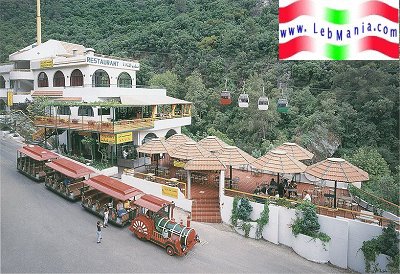
| Information Collected From The Ministry of Tourism |